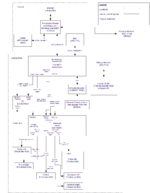Alx9r's Network Attached Storage Setup
| Alx9r's Sample Setup |
I now store my media on a 2-drive Network Attached Storage box. The 2 drives are entirely independent volumes (i.e. not a RAID configuration). Only the second drive is used by LinuxMCE. Every night, a script synchronizes the contents of the first drive with the second drive. See the rationale section below for why I set it up this way.
Originally I opted to use a built-in (sata connected) secondary media storage drive for my hybrid core. That configuration was simple and cheap to set up but suffered from a few shortcomings. You can read about that original setup in earlier versions of this page.
Rationale
Here are some reasons why I set up my media storage the way I did.
- Fresh installations of LinuxMCE can be put on the hybrid/core drive without losing media. If you have only a single drive, you need to use the custom partition installation which is somewhat less-supported.
- The NAS box can be located away from my hybrid/core which cuts down on noise in the living room and heat in the hybrid/core case.
- As compared to adding hard drives to a hybrid/core, NAS offers more flexibility for the same money since I am not limited by the amount of hard drive slots and available connections in my hybrid/core.
- With the DNS-323, syncronizing independent drives nightly is less buggy than RAID1.
- Unlike with RAID1, using one drive as a nightly backup only means that the two drives have a different usage pattern and are unlikely to fail simultaneously.
- Unlike with RAID5, if the NAS box fails I can just plug either of the drives into a PC and recover the contents.
Hardware
I opted to go with the D-Link DNS-323 ($180) which is a two-bay bring-your-own-drives network attached storage box. I put two Seagate Barracuda 7200.11 1.5TB hard drives in the slots which were $225 each.
Setup
There are a number of wikis and forums dedicated to the DNS-323. I'll just provide the general steps that I took to prepare mine. Here is what I did:
- With no hard drives in the slots, I upgraded the DNS-323 firmware to 1.05 using the DNS-323 admin web page.
- Changed the name of the device to NAS-1 from the DNS-323 admin web page.
- Added the drives and used the wizard on the DNS-323 admin web page to format them in "standard" mode. This mode results in two separate volumes called Volume_2 and Volume_1.
- Copied all my media to the LinuxMCE folder structure on Volume_2.
- Installed ffp (aka fun_plug) following these instructions.
- Set up a nightly rsync to copy all of the data from Volume_2 to Volume_1 by following these instructions.
- With the DNS-323 turned off, connected it to the INTERNAL network, then switched it on.
- Once the DNS-323 completed booting, I performed a reload router. After a what seemed like a long time (probably a few minutes), LinuxMCE detected the DNS-323 and asked me if I wanted to use the drive. LinuxMCE prompted for each of three shares that the DNS-323 set up: Volume_1, Volume_2, and web_page. I told LinuxMCE to use only Volume_2 with the LinuxMCE folder structure.
- After this, LinuxMCE displayed that it was "Installing Software" for a few minutes and eventually hung indefinitely doing some sort of "Configuration". I finally, forced reload router, and the DNS-323 was fully set up.
Folder Structure and Media (Pre-Installation)
Before connecting the DNS-323 to LinuxMCE, I created the standard LinuxMCE media drive folder structure on the Volume_2 drive. The structure looks like this:
Volume_2
|-public
|-data
|-videos
|-music
|-pictures
Also before connecting, I moved all of my media to the appropriate folder on the media drive.
| Alx9r's Sample Setup | |
|---|---|
| Materials | Network Gear · Hybrid Core (living room) · AV Gear (living room) · Orbiters · Glue |
| Preparation | Router Setup · Aquos TV Power-on |
| Hybrid Core pre-LinuxMCE Setup | Assembly · BIOS Tweaks · Hardware Testing · NAS Media Drive Setup |
| Hybrid Core LinuxMCE Installation | Bare-metal Install · AV Wizard · Sarah (Setup Wizard) · Special Steps · PVR-150 Remote · Aquos TV · Denon Receiver · Media Drive Setup · Laptop Orbiter · Webpad Orbiter |
| Hybrid Core Additional Software | Bittorrent · Synergy |
| Toolkit | Laptop · telnet/ssh client · Remote Mouse and Keyboard · Partition Tools |
| Design Rationale | Network Topology · NAS |
